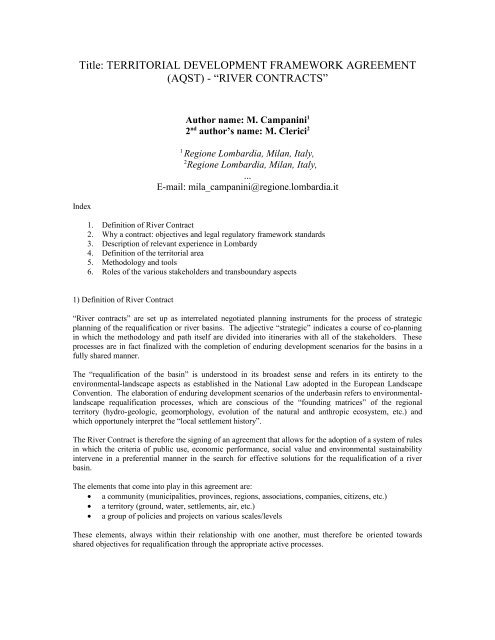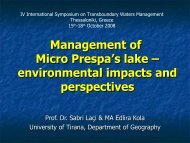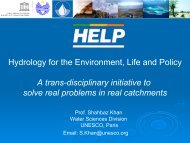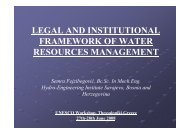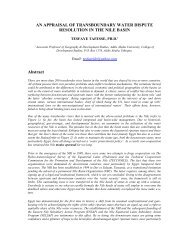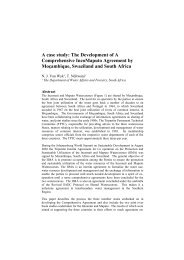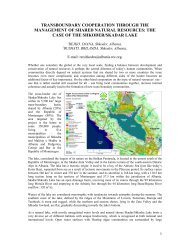Abstract Template - inweb
Abstract Template - inweb
Abstract Template - inweb
You also want an ePaper? Increase the reach of your titles
YUMPU automatically turns print PDFs into web optimized ePapers that Google loves.
Title: TERRITORIAL DEVELOPMENT FRAMEWORK AGREEMENT<br />
(AQST) - “RIVER CONTRACTS”<br />
Index<br />
Author name: M. Campanini 1<br />
2 nd author’s name: M. Clerici 2<br />
1<br />
Regione Lombardia, Milan, Italy,<br />
2<br />
Regione Lombardia, Milan, Italy,<br />
...<br />
E-mail: mila_campanini@regione.lombardia.it<br />
1. Definition of River Contract<br />
2. Why a contract: objectives and legal regulatory framework standards<br />
3. Description of relevant experience in Lombardy<br />
4. Definition of the territorial area<br />
5. Methodology and tools<br />
6. Roles of the various stakeholders and transboundary aspects<br />
1) Definition of River Contract<br />
“River contracts” are set up as interrelated negotiated planning instruments for the process of strategic<br />
planning of the requalification or river basins. The adjective “strategic” indicates a course of co-planning<br />
in which the methodology and path itself are divided into itineraries with all of the stakeholders. These<br />
processes are in fact finalized with the completion of enduring development scenarios for the basins in a<br />
fully shared manner.<br />
The “requalification of the basin” is understood in its broadest sense and refers in its entirety to the<br />
environmental-landscape aspects as established in the National Law adopted in the European Landscape<br />
Convention. The elaboration of enduring development scenarios of the underbasin refers to environmentallandscape<br />
requalification processes, which are conscious of the “founding matrices” of the regional<br />
territory (hydro-geologic, geomorphology, evolution of the natural and anthropic ecosystem, etc.) and<br />
which opportunely interpret the “local settlement history”.<br />
The River Contract is therefore the signing of an agreement that allows for the adoption of a system of rules<br />
in which the criteria of public use, economic performance, social value and environmental sustainability<br />
intervene in a preferential manner in the search for effective solutions for the requalification of a river<br />
basin.<br />
The elements that come into play in this agreement are:<br />
• a community (municipalities, provinces, regions, associations, companies, citizens, etc.)<br />
• a territory (ground, water, settlements, air, etc.)<br />
• a group of policies and projects on various scales/levels<br />
These elements, always within their relationship with one another, must therefore be oriented towards<br />
shared objectives for requalification through the appropriate active processes.
2) Why a contract: objectives and legal regulatory framework standards<br />
The Regional Territorial Plan (PTR) recognizes these processes as an advantageous means for the planning<br />
of river basins: such a choice is set as an interpretation of the values expressed in international protocols,<br />
municipal directives and national and regional regulations that require the reaching of objectives in<br />
reference to water quality, safety, environmental-landscape quality, ecosystems and settlements as well as<br />
governance of the decision processes.<br />
The River Contract therefore enters into a regulatory context represented by Directive 2000/60 of<br />
Legislative Decree 152/06, Law 14/06 (that ratifies the principles of the European Landscape Convention)<br />
and of regional norms and regulations such as: LR 12/2005 (on the governing of the territory), LR 6/73 (on<br />
hydraulic works), LR 2/2003 (on negotiated Planning), PSR 2007/2013 (regarding the Strategy for the<br />
conservation of biodiversity and the System of ecological networks), as well as the Guideline “10,000<br />
hectares of new green areas” and the Implementation Program provided for in DGR 20 December 2006, n.<br />
3839.<br />
The promotion of a River Contract is intended to implement the passage from policies for environmental<br />
conservation to broader policies for the “management of environmental-landscape resources”, operating in<br />
multiple sectors:<br />
- protection and conservation of natural environments<br />
- water conservation<br />
- defense of the land<br />
- protection from hydraulic risk<br />
- conservation of natural beauty<br />
To meet this objective the Cdf’s definition is developed as:<br />
a) a shared strategic scenario, or a medium-long term widely shared strategic vision of local development<br />
that it intends to pursue (intended as a socio-economic model such as landscape in the general sense,<br />
quality of life, etc.) which includes<br />
- a visual representation (cartography)<br />
- an integrated group of development policies/strategies in synergy with each other<br />
The strategic scenario thus built and shared would be able to find its formalization through the<br />
definition of an Area Plan as provided for in the regional urbanistic regulation;<br />
b) an instrument of evaluation of the policies and their effectiveness and coherence with the objectives;<br />
c) planning of the basin which indicates shared and integrated operations and rules to be implemented<br />
within a specific time frame, by the interested parties.<br />
3) Description of relevant experience in Lombardy<br />
Beside the already signed river contracts such as the “Olona, Bozzente and Lura River Contract” and the<br />
“Seveso River Contract”, and the one for the Lambro, for which the “Towards the Lambro River Contract”<br />
process was begun, within the regional territory there are also diverse experiences in various river<br />
underbasins that, although being different, all tend to be developed towards the signing of negotiated<br />
planning agreements.<br />
Although the Olona, Seveso and Lambro River contracts were promoted by the Region, for smaller scale<br />
territorial areas the promoting party can, and in the future may, be an entity that is closer to the location<br />
(Province).
4) Definition of the territorial area<br />
The territorial dimension of a River Contract is represented by the scale of the river basin in question and<br />
can therefore include the territory not only of many municipalities, but also of more than one province, as is<br />
the case of Olona, Seveso and Lambro.<br />
5) Methodology and tools<br />
The undersigned subjects share the principle that only through a synergistic and strong action by all of the<br />
public, private and settlement subjects, can the tendency toward the territorial/environmental degredation of<br />
river basins be reversed and can the objective of their sustainable development be appropriately<br />
accomplished. To that end, they commit, with respect to each of their abilities, to operate within a<br />
framework of strong evaluation of the subsidiarity principle, activating all useful tools for the full<br />
achievement of their shared goals.<br />
The accomplishment of the AQST – River Contract, foresees the development of a methodology that is<br />
articulated into progressive phases and that avails itself of the activation of the tools listed below:<br />
• the construction of a cognitive framework of the criticality of the environmental, landscape and<br />
territorial value, of the local policies and projects on which an operational strategy can be founded;<br />
• the definition of a medium-long term strategic scenario<br />
• the elaboration and successive application of a multi-purpose evaluation model for the evaluation<br />
of those policies in force and planned;<br />
• the proposal of a plan of action for the realization of strategic scenarios and to adequately achieve<br />
the shared goals in an integrated manner.<br />
A preview of such a program is comprised of the “First action plan” in which some already shared<br />
actions intended to confront the most significant emergencies of the basin are identified.<br />
• elaboration and realization of an appropriate communication, training and education plan<br />
6) Roles of the various stakeholders and transboundary aspects<br />
The main effort of the River Contract is to coordinate a variety of politics, plans and programs, regarding<br />
the river basin, that are developed by all the administrative bodies, in order to share a common strategic<br />
scenario and common approaches to the problems of the territory.<br />
Since the actors that are involved in this process are a plenty of villages (almost a hundred of<br />
municipalities), provinces, parks and other local authorities, and, in a future prospective, also private<br />
partners, a great importance is given to the respect of the roles of all the various stakeholders, in order to<br />
minimize interest conflicts.<br />
Conflicts can born not only between public and private sector, but also (and sometimes especially) among<br />
local authorities when programs or projects made from an upstream authority can have negative impacts on<br />
the downstream territories or on the territories placed on the other side of the river.<br />
These problems are common when dealing with water uses conflicts or interfering infrastructure such as<br />
water treating plants, stream-regulating structures, so that a difficult process of negotiation has to be carried<br />
on.<br />
This is the reason why the innovative characteristic of River Contract processes is the choice to go in the<br />
direction of horizontal subsidiarity: the differentiation of the territorial system requires a flexible system of<br />
governance able to settle, on a local level, the conflicts and interests through negotiation processes that<br />
comply with the territorial vocation, and capable of “adopting a system”, making the diverse socioeconomic<br />
intervention planning instruments work along with the territorial planning instruments.
In this case the provinces can have a significant role, even that of covering the Contract promoter, with the<br />
support of other supra-municipal areas such as, for example, the PLIS, the Mountain Communities and the<br />
park entities that will act as catalysts and aggregators for municipal activities.<br />
The Lombardy Region will therefore have the role of elaborating and updating the appropriate guidelines<br />
and addresses, in collaboration with the Po Basin Authority, as well as supporting the provinces by<br />
supplying financing (even through the issuing of calls for tender).<br />
Provide a map of the region showing the rivers where contracts were applied.<br />
Provide some major references.<br />
For your abstract revision, please use the format given in the attached example and<br />
follow the instructions in the text of the example


